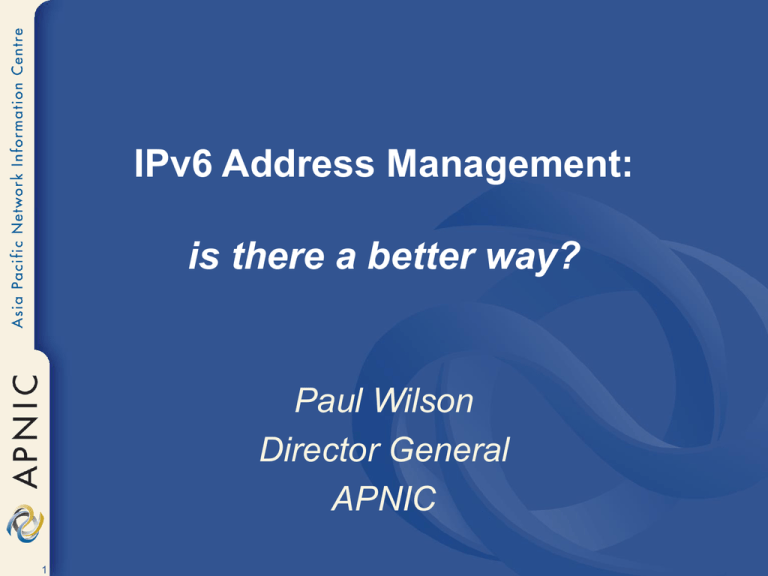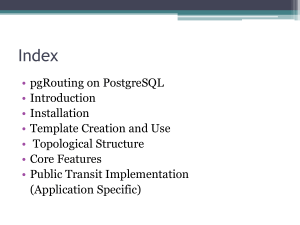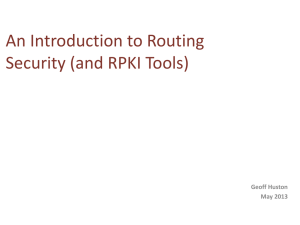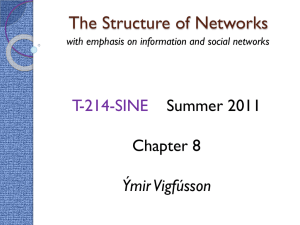PPT - apnic
advertisement

IPv6 Address Management: is there a better way? Paul Wilson Director General APNIC 1 Overview • Introduction – What is an IP address? – IP address routing • How are IP addresses managed? – Administrative and Operational views • Internet architecture and geography • Can we do it better? • Conclusion 2 What is an IP Address? 3 What is an Address? • An identifier which includes information about how to find its subject • (according to some rules of interpretation) • Normally hierarchical – Each part provides more specific detail • For example… – +61 7 3858 3188 – www.apnic.net – pwilson@apnic.net – 202.12.29.142 4 Telephone Network Routing Prefix Table Global +61 7 3858 3188 +1 +44 +61 +886 … Prefix Table +61 National 2 3 7 … Prefix Table … Local 7 5 3858 3188 What is an IP Address? • Internet identifier including information about how to reach a network location • (via the Internet routing system) • IPv4: 32-bit* number – 4 billion different addresses available – E.g. 202.12.29.142 • IPv6: 128-bit* number – 16 billion billion addresses available – E.g. 2001:0400:3c00:: 6 * bit = binary digit Internet Address Routing Global Routing Table The Internet 4.128/9 60.100/16 60.100.0/20 135.22/16 … 202.12.29.0/24 … Announce 202.12.29.0/24 Traffic 202.12.29.0/24 202.12.29.0/24 7 Internet Address Routing Traffic 202.12.29.142 Local Routing Table Local Router 202.12.29.0/25 202.12.29.128/25 202.12.29.142 202.12.29.0/24 8 Global Internet Routing Global Routing Table The Internet 4.128/9 60.100/16 60.100.0/20 135.22/16 … Net Global Routing Table 4.128/9 60.100/16 60.100.0/20 135.22/16 … Net Global Routing Table 4.128/9 60.100/16 60.100.0/20 135.22/16 … Net Net Net Global Routing Table 4.128/9 60.100/16 60.100.0/20 135.22/16 … Global Routing Table 4.128/9 60.100/16 60.100.0/20 135.22/16 … Net 4.128/9 60.100/16 60.100.0/20 135.22/16 … Global Routing Table 4.128/9 60.100/16 60.100.0/20 135.22/16 … Global Routing Table Net 4.128/9 60.100/16 60.100.0/20 135.22/16 … Global Routing Table 4.128/9 60.100/16 60.100.0/20 135.22/16 … Net Net Global Routing Table 4.128/9 60.100/16 60.100.0/20 135.22/16 … Net Global Routing Table 4.128/9 60.100/16 60.100.0/20 135.22/16 … Net 9 Global Routing Table Global Routing Table 4.128/9 60.100/16 60.100.0/20 135.22/16 … What else is an IP Address? • Internet infrastructure addresses • Uniquely assigned to infrastructure elements • Globally visible to the entire Internet • A finite “Common Resource” • Never “owned” by address users • Not dependent upon the DNS 10 IP addresses are not domain names… The Internet DNS 202.112.0.46 www.cernet.cn ? 2001:0400:: 2001:0C00:8888:: My Computer 11 2001:0400:: www.cernet.cn How are IP Addresses managed? Administrative view 12 The early years: 1981 – 1992 1981: “The assignment of numbers is also handled by Jon. If you are developing a protocol or application that will require the use of a link, socket, port, protocol, or network number please contact Jon to receive a number assignment.” (RFC 790) 13 Global Routing Table: ’88 - ’92 9000 8000 7000 6000 5000 4000 3000 2000 1000 0 Jul-88 Jan-89 Jul-89 Jan-90 Jul-90 Jan-91 Jul-91 Jan-92 Jul-92 14 Global Routing Table: ’88 - ’92 100000 90000 80000 70000 60000 50000 40000 30000 20000 10000 0 Jan-89 15 Jan-90 Jan-91 Jan-92 Jan-93 Jan-94 Jan-95 Jan-96 The boom years: 1992 – 2001 1992: “It has become clear that … these problems are likely to become critical within the next one to three years.” (RFC1366) “…it is [now] desirable to consider delegating the registration function to an organization in each of those geographic areas.” (RFC 1338) 16 Recent years: 2002 – 2005 17 Global routing table Sustainable growth? “Dot-Com” boom Projected routing table growth without CIDR CIDR deployment 18 http://bgp.potaroo.net/as1221/bgp-active.html How are IP Addresses managed? Operational view 19 Where do IP addresses come from? IETF IPv4 IPv6 IANA Allocation RIR Allocation Network Assignment User 20 IP Address Aggregation No Aggregation ISP A Aggregation ISP A ISP B Internet ISP B Internet (21 routes) ISP D ISP C (Portable Assignments) 21 (4 routes) ISP D ISP C (Non-portable Assignments) Allocation and assignment APNIC /8 Allocates to APNIC Member APNIC Allocation APNIC Member Allocates to downstream /21 Assigns to end-user Member Allocation /23 Downstream Assigns to end-user SubAllocation /27 Customer / End User 22 /26 /24 /25 /26 Customer Assignments Provider-based address management • Under CIDR, networks are responsible for control of routing table growth – ISP networks receive portable addresses – Customer routes are aggregated • ISP allocations are limited – Must justify a certain “minimum allocation” in order to receive address space • Portable assignments are limited – End users cannot easily obtain portable addresses – Addresses come from upstream ISP 23 Geography of the Internet IP Address view 24 Internet Geography Global Routing Table The Internet 4.128/9 60.100/16 60.100.0/20 135.22/16 … Net Global Routing Table 4.128/9 60.100/16 60.100.0/20 135.22/16 … Net Global Routing Table 4.128/9 60.100/16 60.100.0/20 135.22/16 … Net Net Net Global Routing Table 4.128/9 60.100/16 60.100.0/20 135.22/16 … Global Routing Table 4.128/9 60.100/16 60.100.0/20 135.22/16 … Net 4.128/9 60.100/16 60.100.0/20 135.22/16 … Global Routing Table 4.128/9 60.100/16 60.100.0/20 135.22/16 … Global Routing Table Net 4.128/9 60.100/16 60.100.0/20 135.22/16 … Global Routing Table 4.128/9 60.100/16 60.100.0/20 135.22/16 … Net Net Global Routing Table 4.128/9 60.100/16 60.100.0/20 135.22/16 … Net Global Routing Table 4.128/9 60.100/16 60.100.0/20 135.22/16 … Net 25 Global Routing Table Global Routing Table 4.128/9 60.100/16 60.100.0/20 135.22/16 … Internet Geography • “Nations” of the Internet are networks – “Frontiers” are border routers – “Treaties” are peering relationships between networks • It’s a very dynamic world… – – – – – New nations are formed daily New borders are established hourly Routing tables change by the minute Driven almost entirely by industry No centralised control • Very different from “traditional” networks – Telephony for example 26 How else can we do it? 27 The “old way” • The early IANA model had problems • Administrative centralisation – Alleviated by RIR (and NIR) models • Routing table expansion – Provider-based addressing now necessary for Internet growth and stability – Disadvantage: It is difficult for end-users to receive portable address space – However: some mechanisms exist for special cases 28 Registry-Registrar model (DNS) • Introduced by ICANN for GTDs c.a. 2000 – Also by many countries for ccTLDs DNS Registries DNS Registrars DNS Registrants 29 .com .net .info Non-profit “natural monopoly” organisations For-profit competitive organisations Customers Registry-Registrar model (RIRs) • RIR system already incorporates 2-level model, similar to the new DNS model IP Registries LIRs End users 30 APNIC ARIN RIPE NCC Non-profit “natural monopoly” RIRs For-profit competitive ISPs ISP Customers Competitive RIR Model • RIRs represent single point of unique responsibility, similar to many others… – – – – – DNS registries Root zone manager Standards bodies: ITU, IEEE, W3C International barcode registry Traditional land titles offices etc. • Over the years, some have proposed a system of competitive RIRs – Provide choice to service users – Provide competitive incentive for efficiencies – Better service and lower prices 31 Competitive RIR Model • RIRs hold a responsibility for common outcomes – – – – On behalf of regional and global communities Competitive model is inconsistent with this charter Some central authority cannot be avoided RIR structure and policy development processes provide strong safeguards • Risks – Competition may result in rapid exhaustion of address space – Fragmentation of Internet through inconsistent policies 32 Geographical Distribution • Some have proposed to use a telephonylike model for IP address management • However the geography of telephony is very different – Countries and country prefixes are fixed – Static bi-lateral peering arrangements – Telephone numbers are localised and extensible • To impose a telephony-like regime would impose a major change – Substantial risks involved 33 What are RIRs? 34 What are RIRs? • Regional Internet (address) Registries – Industry self-regulatory structures – Non-profit, open membership bodies • First established in early 1990’s – In response to call from IETF (RFC1366) – To satisfy emerging technical/admin needs – Voluntarily by consensus of community • In the “Internet Tradition” – Consensus-based, open and transparent 35 What do RIRs do? • Internet resource management – Primarily, IP addresses – IPv4 and IPv6 – Registration services (“whois”) • Training, outreach and liaison – Training courses, seminars, conferences… – Liaison: IETF, ICANN, ITU, regional orgs… – Newsletters, reports, web sites… • Policy development and coordination – Open Policy Meetings and processes 36 RIR Policy Development Need Anyone can participate OPEN Evaluate ‘BOTTOM UP’ Implement Internet community proposes and approves policy 37 Discuss TRANSPARENT Consensus All decisions & policies documented & freely available to anyone Summary 38 Summary • Internet address management has a history of 25 years – RIR history is 12 years • Current IP address management system has served the Internet well – Massive expansion and the dot-com boom • Current system is dynamic and able to be changed by evolution – Open policy process • Revolutionary changes to this system have unknown consequences 39 Thank You Paul Wilson pwilson@apnic.net 40







